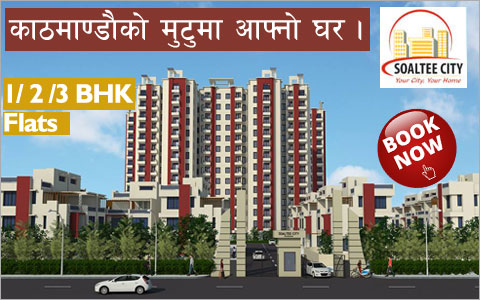National News
His luxury flat had views of the Himalayas to make the heart soar but Dan Bahadur Budhathoki is going to take some persuading to move back into Kathmandu’s 17-storey Park View Horizon apartment block.
Budhathoki was at home on April 25 when Nepal was hit by its deadliest earthquake in eight decades and felt the ground sway under his feet.
“I was really frightened,” said Budhathoki, the boss of a local temping agency who has been living in his office since disaster struck.
The 7.8-magnitude quake killed more than 8,800 people and destroyed nearly 600,000 houses in Nepal, a country where high-rise buildings are still something of a rarity and are limited to Kathmandu.
The quake also damaged another 280,000 houses, leaving hundreds of thousands of people homeless and emptying villages deemed too dangerous for human habitation.
Nepalis watched in horror as clouds of dust rose over the Kathmandu Valley and thousands of poorly constructed houses crumbled to pieces, many of which were home to some of the capital’s poorest residents.
More than two months later, blue tents and makeshift shelters made from iron and tarpaulin still dot Kathmandu’s landscape, offering shelter to working-class families who saw their life savings turned to rubble.
Wealthier residents who live in better-designed buildings by and large emerged unscathed.
When Budhathoki purchased his home in one of the capital’s most desirable addresses, he was given assurances about its capacity to withstand an earthquake.
“The developer said that the building was safe for quakes. Initially it was an 11-storey building but then he got the permit to add six storeys.”
“Maybe that’s the reason for this big damage,” added Budhathoki who heads a group of some 100 apartment owners and tenants demanding compensation.
Before April’s quake, 58 high-rise buildings had been built in Kathmandu while around another dozen projects have received planning permission.
While thousands of one or two-storey buildings were reduced to rubble, none of the tower blocks were toppled.
Park View Horizon is one of two high-rise buildings that have been slapped with a red notice, meaning it needs either major work to make it safe or else must be demolished.
While six buildings sustained no damage at all, the other 50 require lighter remedial work, according to Buddhisagar Thapa, an urban development ministry official who has responsibility for Kathmandu.
Varun Developers, the local offshoot of the Indian construction giant RJCorp which built Park View, says the building does not necessarily have to be razed to the ground and can be made habitable again.
“It will take at least six months but it can be done. The foundations are okay but we are working on strengthening them,” said Amit Gupta, the company’s representative in Nepal.
Gupta insisted construction had conformed to all safety regulations but acknowledged residents were fearful about returning. “Of course, things will never be the same and it will take time but by six months, phobia of high storeys will decrease.”
Budhathoki, who owns twinned apartments on the third and fourth floors, is cool about the prospects of a return with his wife and two children.
“Shall we come back? Wait and see.”
The official line is there is no reason why the quake should signal an end to multi-storey buildings.
“High rises can be built here,” said Thapa. “We are revising the building code so that we can minimise the extent of damage seen in the buildings after the quake and make them more earthquake resistant.”
But experts say the disaster should serve as a wake-up call about the dangers of high-rise buildings in a city with a history of earthquakes.
“No dynamic soil test has been conducted in Kathmandu to measure how the soil will react to seismic waves,” said Deepak Chamlagain, a geology professor at Kathmandu’s Tribhuvan University.
“Some high-rise buildings have been built according to the Indian building code but geological conditions in the Kathmandu Valley are very different because the layer of clay in our soil can amplify the propagation of the seismic wave.”
source: the himalayan times, 9 july 2015
- 9th Nepal Buildcon International Expo 2024
- Real Estate Expo 2023
- NRB raises housing loan limit to encourage home constructions
- Nepal Rastra Bank (NRB) Monetary Policy 2080-2081
- New Price of Land in Kathmandu Metropolitan City, Nepal
- Capital Gains Tax Rate on Real Estate Transactions in Nepal 2080-81 ( 2023/24 )
- Kathmandu metropolis implements free parking policy for commercial buildings and hospitals

![[X]](https://www.housingnepal.com/images/popup-close-button.png)



















































































































































































































































































































































































 Facebook
Facebook
 Delicious
Delicious
 Digg
Digg
 Reddit
Reddit
 Stumble Upon
Stumble Upon









